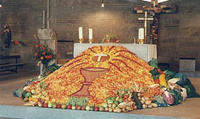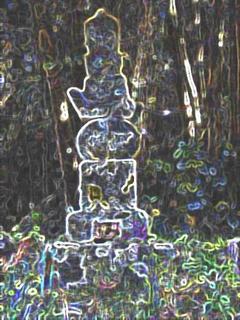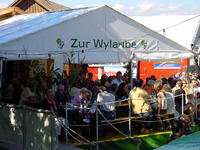:::::::::::::::::::::::::::::::::::::::::::::::::::::::::::::::::::::::::::::::::::::::::::::::::::::
Harvest Thanksgiving, Harvest Festival
(German : Erntedankfest)
***** Location: Worldwide (but not North America)
in Christian countries and parishes
***** Season: Mid-autumn
.............. (Kenya : late cool dry season)
***** Category: Observances
*****************************
Explanation

http://www.landeskirche-sachsen.de/4209.html
A festive Church Service giving thanks to God for a harvest completed. Worshippers bring gifts of crops and food, which are later distributed to the needy.
At this time of declining church attendance, this has become the most popular festival in the annual church calendar, apart from Christmas. The joy of the celebration, the bringing of gifts, the involvement of children, the tangible and even exotic nature of much farm produce, the well-known and favourite hymns, and the special sermons, often by visiting preachers, all go to make this a much-loved occasion which most families would not wish to miss. Even people who have largely lost touch with the church find much to celebrate on this day.
Isabelle Prondzynski
xxxxxxxxxxxxxxxxxxxxxxxxxxxxx
Prayers for Harvest Thanksgiving
From the Church of Ireland (Anglican)
Eternal God,
you crown the year with your goodness
and give us the fruits of the earth in their season:
Grant that we may use them to your glory,
for the relief of those in need
and for our own well-being;
through Jesus Christ our Lord.
Amen
Lord of the harvest,
with joy we have offered thanksgiving
for your love in creation
and have shared in the bread and wine of the kingdom.
By your grace plant within us such reverence
for all that you give us
that will make us wise stewards of the good things we enjoy;
through Jesus Christ our Lord.
Amen.
http://tinyurl.com/7uowh
... ... ...
From the Anglican Church of Kenya
O Lord God our creator and keeper,
giver of sunshine and rain;
all what we are and all what we have is yours,
in gratitude we offer to you, and for your work,
the produce of our farms, businesses and employment.
Accept and bless it for the furtherance of your work here and beyond.
Multiply it to meet all our various needs.
All for the glory and honour of your holy name.
Amen.
Anglican Church of Kenya, Our Modern Services (2002)
xxxxxxxxxxxxxxxxxxxxxxxxxxxxx

Golden Fields
© Photo courtesy of Ken Houston
xxxxxxxxxxxxxxxxxxxxxxxxxxxxx
Every year we have a Harvest Festival in our schools and churches but do you know why?
Thanksgiving ceremonies and celebrations for a successful harvest are both worldwide and very ancient.
In England, we have given thanks for successful harvests since pagan times. We celebrate this day by singing, praying and decorating our churches with baskets of fruit and food in a festival known as 'Harvest Festival', usually during the month of September.
Harvest Festival reminds Christians of all the good things God gives them. This makes them want to share with others who are not so fortunate. In schools and in Churches, people bring food from home to a Harvest Festival Service. After the service, the food that has been put on display is usually made into parcels and given to people in need.
When is Harvest Festival?
Harvest festivals are traditionally held on or near the Sunday of the Harvest Moon. This moon is the full moon which falls in the month of September, at or around the time of the Autumnal Equinox, about Sept. 23.
History of Harvest Festival - Traditions and Customs
Harvest Festival used to be celebrated at the beginning of the Harvest season on 1 August and was called Lammas, meaning 'loaf Mass'. Farmers made loaves of bread from the new wheat crop and gave them to their local church. They were then used as the Communion bread during a special mass thanking God for the harvest. The custom ended when Henry VIII broke away from the Catholic Church, and nowadays we have harvest festivals at the end of the season.
Farmers celebrated the end of the harvest with a big meal called a harvest supper, eaten on Michaelmas Day. This was rather like a Christmas dinner, but as turkeys were unknown at that time, a goose stuffed with apples was eaten. Goose Fairs are still held in some English towns, but geese are no longer sold.
The tradition of celebrating Harvest Festival in churches as we know it today began in 1843, when the Reverend Robert Hawker invited parishioners to a special thanksgiving service for the harvest at his church at Morwenstow in Cornwall*. Victorian hymns such as "We plough the fields and scatter", "Come ye thankful people, come" and "All things bright and beautiful" helped popularise his idea of harvest festival and spread the annual custom of decorating churches with home-grown produce for the Harvest Festival service.
*Information taken from Oxford Dictionary of English Folklore

© Woodlands Junior School
Woodlands Junior School, Hunt Road Tonbridge Kent.TN10 4BB UK
http://www.woodlands-junior.kent.sch.uk/customs/Harvest.html
xxxxxxxxxxxxxxxxxxxxxxxxxxxxx
Links to popular Harvest Thanksgiving hymns
We plough the fields and scatter
(Wir pflügen und wir streuen), by Matthias Claudius
http://www.cgmusic.com/cghymnal/others/w/weploughthefields.htm
Now thank we all our God
(Nun danket alle Gott), by Martin Rinkart
http://www.cyberhymnal.org/htm/n/o/nowthank.htm
Come ye thankful people come, by Henry Alford
http://www.cyberhymnal.org/htm/c/o/comeytpc.htm
All things bright and beautiful
http://www.oremus.org/hymnal/a/a177.html
*****************************
Worldwide use
Australia
In the Southern Hemisphere the tradition of giving thanks for the harvest, where it survives, or in some places where it is a recovered tradition, occurs naturally in Autumn (Fall) and being commonly in the months of March or April tends often to coincide with one of the Sundays of Lent. That is a coincidence that does not fit easily with the Christian calender developed in the Northern Hemisphere.
Nevertheless I am including resources for such a celebration at this point in accordance with local tradition, for it is important that we should "always and everywhere give thanks."
http://www.beswick.info/rclresources/HThg95L3COS.htm
xxxxxxxxxxxxxxxxxxxxxxxxxxxxx
Germany
Erntedankfest, Erntefest
In Germany, the harvest thanksgiving festival (Erntedankfest) is always celebrated on the first Sunday in October by Roman Catholic congregations, and on the Sunday nearest Michaelmas (29 September) by Protestant congregations.

The Services are often followed by processions bearing the Harvest Crown, and in many places, a Harvest Queen is the Guest of Honour. Village fairs may be held. The annual return of the cows from their Alpine summer pasture may also be celebrated on the same day. In wine-growing regions, Harvest Festivals have in recent years given way to vintners' festivals.
Information taken from
http://www.feiertagsseiten.de/erntedankfest/home.html
... ... ...
Harvest Crown, Harvest Wreath : Erntekrone, Erntekranz

http://www.bauernverband.de/archiv_1766.html
http://www.landeskirche-sachsen.de/4209.html
http://www.lauenhagen.de/Touristik/Bilder/EFst05Gal14/EF05Pics122/ef05pics122.html
Harvest Queen : Erntekoenigin
http://erntefest-steinbeck.de/erntekoenigin.htm
.. .. ..
More information and further links here :
http://de.wikipedia.org/wiki/Erntedankfest
xxxxxxxxxxxxxxxxxxxxxxxxxxxxx
Japan
The autumn festivals in all villages belong to this kind.
Autumn Festival (aki matsuri)

© 2001,勝浦川流域ネットワーク
http://www.soratoumi.com/river/ryuiki/syukaku.htm
At the rural schools, we celebrate the Harvest Festival, shuukakusai 収穫祭. New rice of the season is pounded for rice cakes. Self-grown vegetables make a delicious soup and many art objects made of fruit, nuts and other natural materials are on display.
Pounding rice (mochi tsuki) is itself a kigo for winter.
Official Harvest Festival, niiname no matsuri 新嘗祭
Great Harvest Ceremony, oonie matsuri 大嘗祭
Labour Thanksgiving Day 勤労感謝の日
kinroo kansha no hi, Japan, November 23
Gabi Greve
xxxxxxxxxxxxxxxxxxxxxxxxxxxxx
Kenya
See Nairobi International Trade Fair , which starts each year with Harvest Thanksgiving Service in All Saints' Cathedral Nairobi.
xxxxxxxxxxxxxxxxxxxxxxxxxxxxx
Jews celebrate Sukkot (Festival of Booths)
at the same time of year and for the same reason.
Four days after Yom Kippur, Jews world-wide celebrate the holiday of Sukkot. The holiday is celebrated from the 15th of Tishri through the 21st or 22nd of Tishri, depending if you live in Israel or in the Diaspora. Sukkot usually falls out in late September or early October.
After the harvest from your threshing floor and your vineyards, you shall celebrate the Feast of Booths for seven days. (Deuteronomy 16:13)
Historically, Sukkot commemorates the wanderings of the Israelites, which began with the exodus from Egypt (Passover) and continues with the giving of the Torah at Sinai (Shavuot) and ends with the wandering in the desert for the full 40 years as punishment for the sin of the golden calf.
To celebrate their hard work, the farmers and their families would go to the temple in Jerusalem to offer thanks. They built sukkot, or booths, to remember how the children of Israel built booths in the desert. The pilgrims lived in them for seven days while they, and the families they brought to Jerusalem, celebrated.
In modern times, the custom of building sukkot was reestablished in the early 1900s. Since then, Jews everywhere celebrate the seven or eight days of Sukkot, (depending where you live) including Shemini Atzeret and Simhat Torah from the Diaspora and from Israel.
© 1998-1999 Everything Jewish, Inc.
http://www.everythingjewish.com/Sukkot/Sukkot_origins.htm
xxxxxxxxxxxxxxxxxxxxxxxxxxxxx
Hindu faithful, particularly in Tamil Nadu, celebrate Pongal, another week-long harvest festival.
http://www.bawarchi.com/festivals/pongal.html
http://members.tripod.com/~jap5/hindufestivals/pongal.html
*****************************
Things found on the way
*****************************
HAIKU
In the Nairobi slum where I have been working, the week after Harvest Thanksgiving Sunday is that one of the year when the nursery school meal goes beyond the plain and cheap, as the harvest gifts brought to the church are distributed. What delight they bring to the children!
fruit for lunch today --
harvest thanksgiving
yesterday
Isabelle Prondzynski
xxxxxxxxxxxxxxxxxxxxxxxxxxxxx
the harvest season -
the family dressed for sunday
smiles for the photo
Robert Leechford
http://home.alc.co.jp/db/owa/PH_detail?photo_sn_in=38
xxxxxxxxxxxxxxxxxxxxxxxxxxxxx
featherless bird (tofu turky)
harvest from the garden
alas no drummsticks
Shanna Moore
*****************************
Related words
***** Thanksgiving (U.S.A.)
***** Grape Festival (Winzerfest, Wine Festival) (Europe)
***** Nairobi International Trade Fair (Kenya)
. Harvest and related kigo
[ . BACK to WORLDKIGO . TOP . ]
:::::::::::::::::::::::::::::::::::::::::::::::::::::::::::::::::::::::::::::::::::::::::::::::::::::



































